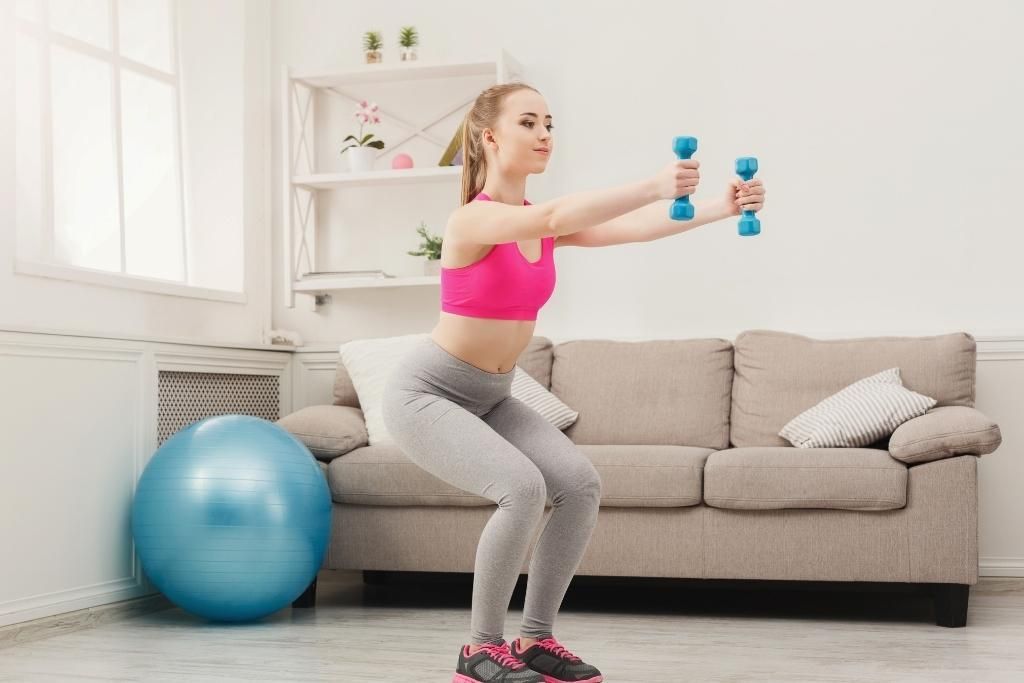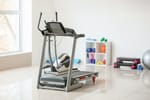If you’ve ever wanted to learn how to quickly perform a fat-burning workout virtually anywhere, you’re in luck today! That’s because this quick guide will reveal some of the most effective exercises that can help you build lean muscles mainly using your own body weight.
What Are Bodyweight Exercises?
Bodyweight exercises are exercises that can be performed without the use of gym equipment such as barbells, dumbbells, or machines. These exercises solely depend upon your own body weight to provide the resistance that your muscles push against in order to get slim and toned.
I’m fully aware of the fact that as humans we have more tasks to do on a daily basis than we have time to get them done.
And because of that reason, I decided to create this method for you.
The biggest roadblock that my personal training clients faced was the lack of time to make it to the gym.
To be honest, I thought that they were making excuses…
Fast-forward to the present, now that I have my own family, I can definitely relate to them.
However, just because you and I don’t have a lot of surplus time on our hands, that’s no reason to not get a quick workout in…
And yes, I’m including myself because my daily schedule is packed with things to do and sometimes I don’t feel like working out, but I do so anyway.
Let’s get to it…
The one thing I always get asked about using bodyweight exercises is can I really build lean muscle without using the equipment?
My answer is a resounding yes!
Bodyweight exercises are perfect for when you want to get a quick workout in when you don’t have access to any fitness equipment.
The Top Places To Use Bodyweight Exercises:
- During your breaks at work (even if you own the business)
- At home as an alternative to your regular resistance training workouts
- While waiting in lines (well, there are a few that you can perform)
- During your walks (especially at a park)
Examples Of Bodyweight Exercises:
- Squats
- Lunges
- Standing Calf Raises
- Seated Calf Raises (Pressing Downward On Knees)
- Push-ups (Beginner(knees bent) & Advanced)
- Reversed Triceps Extensions
- Wall Presses
- Lying Crunches
Important Note: I don’t recommend permanently using Bodyweight Exercises to replace resistance training performed using home-based fitness equipment as you’d be limiting your progress due to not training all of your body parts, not to mention the challenge that you’d have when you want to increase the intensity.
For example, when you look at the bodyweight exercises that I listed above, notice that none of them focuses on your Biceps, Back, Hamstrings, Forearms, or Shoulders.
Now I don’t want you to be discouraged and not use bodyweight exercises, but I must share with you the positives and the negatives of these types of workouts.
I’ve been incorporating bodyweight exercises into my workout routines for years with great results and there’s no reason why you shouldn’t either.
Now that you have a brief understanding of what bodyweight exercises are, let me show you an example of a quick and effective routine that you can begin using today…
The 10-Minute Bodyweight Exercise Routine
In keeping with my ongoing theme for the Calorieburnology System, let’s get right to the point by showing you a great routine that you can get done in about 10 minutes.
What makes this bodyweight routine so effective is the fact that you will be performing the exercises using a technique called Giant Sets, where you execute each movement on the list non-stop until you’ve completed them all, which would be considered one set.
For example, you’d perform 12 reps of Squats, with no rest you’d then perform 10 reps of Lunges, then 13 reps of Standing Calf Raises, then 15 reps of Seated Calf Raises (Pressing Downward On Knees), then 10 reps of Push-ups (Beginner (knees bent), then 10 reps of Reverse Triceps Extensions, 12 reps of Wall Presses, and finally you’d complete the Giant Set by performing 12 reps of Lying Crunches.
Keep in mind that your number of reps may be more or less depending upon what level of shape you’re in.
TIP: If you can’t make it through the entire list in a non-stop manner, it's okay just catch your breath for 30 seconds to 1 minute then continue down the list until you’ve completed all the exercises on the list. Trust me you’ll still get a great workout!
Also, if you’re up to the challenge you can always perform two Giant Sets, but be sure to not overdo it because you have plenty of time to build your endurance over time. The last thing you want to do is overexert yourself and end up with several injuries.
Equipment Needed: Your Own Bodyweight
| Objective | Duration | Sets | Reps | Rest | Speed |
|---|---|---|---|---|---|
| Muscle Toning | 1 Week | 1 to 2 | 10 to 15 per exercise | 1 to 2 mins after performing all the exercises | Slow & Controlled |
Get Set Exercise List
| Exercise Movement | Muscle Group Trained |
|---|---|
| Squats | Quadriceps (Front Thigh) |
| Lunges | Quadriceps (Front Thigh) & Glutes |
| Standing Calf Raises | Gastrocnemius (Upper Calf) |
| Seated Calf Raises (Pressing Downward On Knees) | Soleus (Lower Calf) |
| Push-ups (Beginner(knees bent) & Advanced) | Pectorials (Chest) |
| Reversed Triceps Extensions | Triceps |
| Wall Presses | Pectorials (Chest) |
| Lying Crunches | Upper Abdominal Muscles |
NOTE: Remember when you perform all the exercises on the Giant Set Exercise List that is considered one set.
How To Perform Each Exercise Movement
Squats
Execution: Stand with feet evenly spaced shoulders width apart (or slightly wider). Descend slowly into a squat position until your thighs are parallel to the floor while keeping the torso and back erect. Before ascending, the chest should be the first muscle to start the upward motion. In other words, push your chest upward towards the ceiling then push with your thighs. Perform the targeted or specified number of reps.
Breathing Technique:
- Inhale on the descend
- Exhale on the ascend
Lunges
Execution: Stand with feet evenly spaced shoulders width apart (or slightly wider). Slowly lunge forward and land on the heel of that foot with feet pointing directly ahead or slightly outward, stop when your upper thigh is parallel with the floor while keeping your torso erect. Make sure your knee doesn’t go over your toes. Now push off through the heel of that foot to return to the starting position to where both of your feet are evenly spaced shoulder width apart. Perform the targeted or specified number of reps.
Breathing Technique:
- Inhale on the descend
- Exhale on the ascend
Standing Calf Raises
Execution: Slowly raise the heels of your feet up as high as possible and hold for a count of two seconds in this top position. Then slowly lower your heels back down to the bottom. Perform the targeted or specified number of reps.
Breathing Technique:
- Inhale while lowering your heels
- Exhale when raising the heels
Seated Calf Raises
Execution: Assume a seated position on a chair. Place feet pointed out slightly. Begin pressing down on your knees as you slowly raise the heels of your feet up as high as possible and hold for a count of two seconds in this top position. Then slowly lower your heels back down to the bottom. Perform the targeted or specified number of reps.
Breathing Technique:
- Inhale while lowering your heels
- Exhale when raising the heels
Push-ups (Beginner-Style)
Execution: Lay flat on your stomach; place your hands approximately 12 inches away from your body. While keeping your knees on the floor, curl your feet towards your butt. With your feet still in an upward position, push up your upper body. Then slowly return to the starting position. Perform the targeted or specified number of reps.
Breathing Technique:
- Exhale while pushing up your upper body
- Inhale when lowering your upper body back to the starting position
Reversed Triceps Extensions
Execution: Sit down on the edge of a stationary (non-rolling) chair, now grip the front of the chair’s seat with both hands (knuckles facing forward). Now move both feet slightly forward, while keeping your heels flat on the floor. Now slowly lower your butt towards the floor, then stop at a point where you are confident you can push back up to the starting position. Perform the targeted or specified number of reps.
Breathing Technique:
- Inhale while lowering your torso toward the floor
- Exhale while pushing your torso back up to the starting point
Wall Presses
Execution: In front of a wall, stand several feet away with your feet evenly spaced shoulders width apart (or slightly wider). Now hold your hands out towards your sides away from your body with palms facing forward. Then lean forward so that both of your hands make contact with the wall. Now slowly move your chest towards the wall. Then push your upper body away from the wall and back to the starting position. Perform the targeted or specified number of reps.
Breathing Technique:
- Inhale while moving your chest toward the wall
- Exhale while pushing your chest away from the wall
Lying Crunches
Execution: Lie flat on your back then place your feet on top of a flat bench (your lower legs should be parallel with the floor and should form a 90-degree angle in combination with your thighs). Place your hands behind your head and raise your head and shoulders off the floor curling them slightly forward reaching with your chin. Slowly return back to the starting position. Perform the targeted or specified number of reps.
Breathing Technique:
- Exhale while curling your shoulders and head forward
- Inhale while returning to the starting position
Applying The 10 Minute Bodyweight Exercise Routine
Here’s an example of how to apply the bodyweight routine to your weekly schedule…
Legend:
- GSR = Giant Set Routine
- Walk @ Lunch = Walk during lunch
- Walk @ Break = Walk during a break
- Walk @ Park = Walk at the park
| Day 1 or Monday | GSR (before work) | Walk @ Lunch |
|---|---|
| Day 2 or Tuesday | Walk @ Lunch |
| Day 3 or Wednesday | GSR (before work) | Walk @ Break |
| Day 4 or Thursday | Walk @ Lunch |
| Day 5 or Friday | GSR (before work) | Walk @ Lunch |
| Day 6 or Saturday | Walk @ Park |
| Day 7 or Sunday | Take a day off (You deserve it) |
Tips To Increase Your Intensity Levels And Burn More Calories
- Always strive to perform at least 1 or 2 more reps beyond your targeted number
- For example, if you strive to perform 12 reps, then go for 14 reps as this will prevent your muscles from hitting a plateau causing you to not make progress.
- Be consistent by not missing any of your scheduled workouts. If you're going to be inconsistent you might as well not work out because you most likely will not make much progress physically.
- It's very important that you perform each exercise as perfectly as you can and always strive to perfect how you do each exercise. This proper way of performing each exercise is called "Form." So, make certain that your form is correct as you can get it.
- Changing your workouts every 2 to 4 weeks keeps your body off-guard which will allow you to make continuous progress. It’s worth mentioning again here; don’t permanently use Bodyweight Exercises to replace resistance training performed using home-based fitness equipment as you’d be limiting your progress due to not training all of your body parts not to mention the challenge that you’d have when you want to increase the intensity.
Quick Nutrition Tips
Please don’t take the following nutrition tips lightly because they are based upon proven scientific research that’s taken place over decades. Apply them if you want to lose weight and gain lean muscle mass. Keep your Basal Metabolic Rate (BMR) a.k.a “Resting Metabolic Rate” in the forefront of your mind 24 hours per day, because it's one of the most influential factors that dictate how much fat you lose.
- Eat 5 to 7 small meals per day
- Eat every 2 to 3 hours apart
- Eat just enough to sustain your energy levels based upon what your activity levels will be within the next 2 to 3 hours from the last meal you consumed
- Consume 4 to 8 glasses of water per day
- Apply the 1:2:3 Ratio Rule - This is where you eat 1 Part Fat, 2 Parts Protein, and 3 Parts Complex Carbohydrates during each small meal
- Eat fewer calories than your body requires on days you DO NOT workout (e.g. 2500 calories instead of 3000)
- Eat slightly more calories than your body requires on days you DO workout (e.g. 3500 calories instead of 3000)
- Add supplements (e.g. multivitamins, antioxidants) to your diet to avoid deficiencies because it's challenging to eat balanced meals
- Only feed your lean muscle mass and not your fat mass
- At the end of the day, you’ll want to have spread out the consumption of the total amount of calories your body requires (e.g. 2500) over 5 to 7 meals
Try your best to never miss a meal to avoid unstable blood sugar levels and weight gain
General Weight Loss And Weight Gain Rules
Weight Loss Rule: To lose weight you must consume FEWER calories than your body needs
Weight Gain Rule: To gain weight you must consume MORE calories than your body needs
What Does It Take To Lose 1 Pound Of Body Fat?
To lose 1 pound of body fat per week, you must consume 500 calories less than what your body needs on a daily basis.
One pound of fat = 3500 Calories
If you divide 3500 Calories by 7 days = 500 calories
500 Calories x 7 days = 3500
Quick Workout Tips
Time Under Tension: After you've mastered how to safely perform an exercise movement (e.g. Squats), you must practice how to move your body weight from both the Starting and Ending Positions faster and faster without hurting yourself. This is what we call "Time Under Tension."
You are simply performing the bodyweight exercises as fast as you can in a controlled fashion (NOT JERKING OR SWINGING, there's a difference) by using your muscles (NOT MOMENTUM).
Safety Tips:
a)) Don't apply the "Time Under Tension" method until you've mastered a particular exercise movement (e.g. Push-ups), developed more strength, and flexibility in your muscles
b)) Wait until you've trained consistently for at least 4 to 6 weeks before implementing the "Time Under Tension" method so that you can build a solid physical foundation first to avoid injuries. This applies to both bodyweight exercises and those where you use resistance movements (e.g. dumbbells, machines, etc...).
Squeeze Out Additional Repetitions
Always attempt to perform an extra 1 to 3 repetitions above the assigned number as long as you’re able to maintain good form. For example; let’s say that you’re supposed to perform 12 to 15 repetitions of Stability Ball Squats. Performing extra reps will force your muscles to adapt and grow stronger in order to handle those extra repetitions. If you don’t constantly challenge your muscles, you will stop making progress, because they’ll have NO Reason to continue getting stronger and leaner.
NOTE: If you ever start feeling tired or frequently experience muscle soreness for prolonged periods of time after you start performing 1 to 3 more repetitions than the assigned, then stop for about 1 to 2 weeks to allow your muscles to recover. Prolonged muscle soreness or weakness are signs of overtraining.
Let’s wrap this up so that you can put this amazing bodyweight routine into practice starting today…
Conclusion
You just discovered what bodyweight exercises are and a simple but highly effective body-slimming workout routine that you can start today.
Like I always say– just knowing the importance of bodyweight exercises isn’t going to magically melt those extra pounds off your body.
That’s because the key is you need to take action on what you just learned. And that’s why I encourage you to apply The 10 Minute Bodyweight Exercise Routine because the sooner you do, the sooner you’ll start losing weight and get closer to the body you dream of!
Download Our Free E-book!







